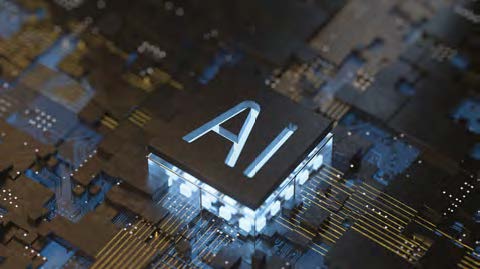Investment Manager's Core Themes
The financial information set out below does not constitute the company's statutory accounts for the years ended 30 April 2023 or 30 April 2022 but is derived from those accounts. Statutory accounts for 2021 have been delivered to the registrar of companies, and those for 2022 will be delivered in due course. The auditor has reported on those accounts; their reports were (i) unqualified, (ii) did not include a reference to any matters to which the auditor drew attention by way of emphasis without qualifying their report and (iii) did not contain a statement under section 498 (2) or (3) of the Companies Act 2006.
The full Annual Report and Financial Statements for the Year Ending 30 April 2023 can be found here.
Cloud Infrastructure / Cybersecurity
Cloud spending has decelerated as customers optimised their spend following rapid growth during covid, but the emergence of AI could provide another long-term growth driver given the enormous amount of compute required to train large language models.
We’re excited about…
The industry continues to deliver solid growth even as customers digest some pull forward of digital transformation spending, with the three dominant vendors (Amazon, Microsoft, and Google) are still growing >20% at a >$170bn combined revenue run rate. Excitement around AI continues to support cloud capital spending growth, with much of the value of early AI adoption captured by the dominant semiconductor providers including NVIDIA and AMD. Overall cloud revenues expected to increase 4x by 2030 to >$1.35trn, assuming incremental cloud revenue added can still grow at a 25% Compunded Annual Growth Rate (CAGR). This would take the cloud’s share of overall IT spending from c17% in 2022 to c36% by 2030. Cloud computing must also be secure, which has supported cybersecurity growth trends and remains at the top of Chief Information Officers’ priority lists.
Current holdings
Amazon.com, Microsoft, Alphabet, Arista Networks, Advanced Micro Devices, Nvidia, Palo Alto Networks, CrowdStrike
Representing 30.4% of NAV at 30 April 2023

Connectivity & 5G/IOT
The smartphone market is mature but Apple’s position atop it looks unchallengeable. While the excitement around 5G has diminished, the infrastructure build out is very much still in progress, with slower US spending offset by rapid growth in India and other emerging markets. The internet of things (IOT) continues to expand, there are hopes AI could supercharge both adoption and utility.
We’re excited about…
Apple’s historic success in bringing new technological breakthroughs to the mass affluent market should position it well for the coming wave of AI-based innovation. As the services consumers continue to access via their primary device become more valuable, so should consumers’ willingness to pay Apple for access to the mobile web ecosystem also move higher.
AI could breathe new life into trends such as digital twins and drive an inflection in adoption. Digital twins exist in many industries including healthcare, automotive, industrial, commerce and manufacturing but are under-utilised, with the adoption rate between 8-10%. AI could enable digital twins to become ’smart’ and autonomous, essential to analyse vast amounts of real-time data produced by connected sensors. Simulations are used by designers to observe ‘What if?’ scenarios, but AI-powered digital twins are virtual environments that can interact with and update in real time and massively increase their functionality.
Current holdings
Apple, Qualcomm, Taiwan Semiconductor, Lattice Semiconductor, ASML
Representing 17% of NAV at 30 April 2023

Digital Advertising / Ecommerce
Digital advertising and ecommerce channels captured an outsized portion of share from traditional channels during the pandemic. However, as the world began to reopen, e-commerce growth rates declined sharply against very challenging Covid comparators – even dipping below trend and further compounded by a switch in consumer spending from goods to services spending.
We’re excited about…
E-commerce has several structural tailwinds which should continue to support a low double-digit growth CAGR through 2030. Bernstein estimate an 11.5% CAGR in the US through 2030 to reach 26% online penetration as a total percentage of retail sales, and a global CAGR of 13% to reach 22%. The e-commerce proposition continues to evolve to offer more value to consumers and producers alike including new models such as on-demand delivery, low-cost direct-to-consumer Chinese players, pre-used marketplaces, and new modalities like social commerce. The Covid overbuild will pay an ‘infrastructure dividend’ as volumes catch up to capacity and per-unit delivery economics continue to improve.
Digital advertising appears more mature with penetration at more than 60% (some estimate as high as 70%) and close to 50% ex-search. Retail media (likened to paying for shelf-space in the physical world) and linear TV advertising still present new market opportunities sized at >$100bn each. Going forward, the market will become more cyclical and more closely tied to overall advertising budget growth but will benefit from a cyclical upturn. Depressed valuation multiples and highly cash-generative business models offer the possibility of strong stock performance when cyclical trends inflect or secular headwinds (IDFA, TikTok) abate.
Current holdings
Alphabet, Amazon.com, Meta Platforms, MercadoLibre, Shopify, Alibaba, Airbnb
Representing 14% of NAV at 30 April 2023

Software & Digital Transformation
According to Gartner, enterprise software had grown at an 11% 10-year CAGR to reach c$600bn to made up 16% of total IT spending in 2020 and is expected to continue to grow at a similar rate to reach 25% of IT spending by 2030. Net new cloud workloads and on-premise workload migrations have delivered higher net new cloud revenue every year for a decade.
We’re excited about…
We agree with Microsoft CEO Satya Nadella’s estimate that technology spending as a percentage of GDP could double in the next ten years as the digital transformation imperative continues to drive change. We can already see the increasing importance of software as a percentage of GDP as software private fixed investment increased from $68bn in 1995 to $578bn in 2022, increasing from 0.83% of GDP to 2.3%, using the Bureau of Economic Analysis’s data. The digital transformation market has been sized at $595bn in 2022 and is projected to grow at a 21% CAGR through 2027 to exceed c$1.5trn.The proliferation of product-led growth (PLG) software models has been driven by the convergence of several major technological and business trends. This model uses the software product itself is the primary sales vehicle to attract, monetize and retain customers, relying on customers self-serving to land small and then expand virally over time. Given the relatively low cost of incremental sales, this business model may even be an improvement to the outstanding economic model software companies already enjoy at scale.
Current holdings
Microsoft, HubSpot, ServiceNow, Workday, Atlassian, Salesforce.com
Representing 17% of NAV at 30 April 2023

Data Economy & Artificial Intelligence
Recent AI breakthroughs following Google’s invention of the transformer model (2017) and the development of large language models have led to an inflection point in AI capabilities as their performance scales with the number of parameters. The launch of ChatGPT in November 2022 provided the catalyst for their widespread adoption and the ‘iPhone moment’ as the innovative natural language user interface drove rapid adoption.
We’re excited about…
AI is set to be the next major secular technology trend driving the sector’s growth. The early beneficiaries largely reside in the technology stack which powers the training and inference operations of large language models, particularly semiconductors. Given the extraordinary scale and technical expertise required, the vast majority of large language model training activity has so far taken place in the public cloud. The quantity and quality of data on which models are trained makes a material difference to their performance, so there may be large growth opportunities for infrastructure software companies whose products can help with the collection and management of vast datasets. We are hugely excited about the potential for AI to become a general purpose technology (GPT) around which ‘everything’ is reimagined, as was the case with earlier GPTs such as the steam engine, electricity and, more recently, the internet.
Current holdings
Nvidia, Monolithic Power Systems, Advanced Micro Devices, Pure Storage, Snowflake, MongoDB, Samsung Electronics
Representing 14.2% of NAV at 30 April 2023

Mobility & EV / Energy Transition
Automotive sales have been impacted by supply-chain disruption, particularly microcontrollers and power semiconductors. However, there were also signs of weakening demand as the year progressed, driven by macroeconomic headwinds including high inflation and interest rates. The long-term themes – electrification; autonomy; mobility – continue to play out.
We’re excited about…
Electric vehicle (EV) adoption has inflected globally: the International Energy Agency (IEA) expects electric vehicles to reach 18% of vehicles on the road in 2023, up from 4% in 2020.This has been driven by a combination of government support/regulation, new product introductions (automakers have committed over a half a trillion dollars to the EV transition) and consumer interest. This also represents a very large market expansion for semiconductors (especially power semiconductors) as a typical EV has >2x as much semiconductor content than a comparable internal combustion engine (ICE) vehicle. Low-level ADAS (advanced driver assistance systems), such as automatic emergency braking, reached 42% penetration and industry observers still expect level 4/5 vehicles to enter the market in the 2025-30 timeframe. The passing of the Inflation Reduction Act (IRA) was a watershed moment for long-term cleantech funding and a key growth driver for the EV sector, expanding the $7,500 tax credit to EV buyers and up to $45 per kWh of credit for producers of battery cells/modules if a sufficient percentage of the materials/ manufacturing are done in the US.
Current holdings
Tesla Motors, BYD, ON Semiconductor, Analog Devices, Infineon Technologies, Enphase Energy
Representing 4.8% of NAV at 30 April 2023
